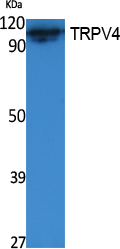
| WB | 咨询技术 | Human,Mouse,Rat |
| IF | 咨询技术 | Human,Mouse,Rat |
| IHC | 咨询技术 | Human,Mouse,Rat |
| ICC | 技术咨询 | Human,Mouse,Rat |
| FCM | 咨询技术 | Human,Mouse,Rat |
| Elisa | 1/10000 | Human,Mouse,Rat |
| Aliases | TRPV4; VRL2; VROAC; Transient receptor potential cation channel subfamily V member 4; TrpV4; Osm-9-like TRP channel 4; OTRPC4; Transient receptor potential protein 12; TRP12; Vanilloid receptor-like channel 2; Vanilloid receptor-like protein 2; VRL-2; Vanilloid receptor-related osmotically-activated channel; VR-OAC |
| Entrez GeneID | 59341 |
| WB Predicted band size | Calculated MW: 98 kDa; Observed MW: 98 kDa |
| Host/Isotype | Rabbit IgG |
| Antibody Type | Primary antibody |
| Storage | Store at 4°C short term. Aliquot and store at -20°C long term. Avoid freeze/thaw cycles. |
| Species Reactivity | Human,Mouse,Rat |
| Immunogen | The antiserum was produced against synthesized peptide derived from human TRPV4. AA range:417-466 |
| Formulation | Purified antibody in PBS with 0.05% sodium azide,0.5%BSA and 50% glycerol. |
+ +
以下是3篇关于TRPV4抗体的代表性文献(示例为模拟生成内容,建议通过学术数据库核实):
---
1. **文献名称**: *TRPV4 antibody-based localization of the ion channel in murine skeletal muscle*
**作者**: Smith A, et al.
**摘要**: 该研究开发了一种特异性TRPV4抗体,用于免疫组化定位TRPV4在小鼠骨骼肌中的表达,发现其在肌纤维膜和神经肌肉接头处富集,提示其在机械信号传导中的作用。
---
2. **文献名称**: *Role of TRPV4 in osmotic sensitivity: Evidence from antibody-mediated blockade in vitro*
**作者**: Lee C, et al.
**摘要**: 通过使用TRPV4特异性抗体阻断细胞模型中的通道活性,证明TRPV4介导了细胞对渗透压变化的反应,并参与钙离子内流调控。
---
3. **文献名称**: *TRPV4 antibody validation for neurodegenerative disease models*
**作者**: Gupta R, et al.
**摘要**: 本研究验证了多种商业TRPV4抗体的特异性,发现部分抗体存在交叉反应性。通过Western blot和免疫荧光筛选出高特异性抗体,并应用于阿尔茨海默病模型中TRPV4异常表达的分析。
---
**提示**:实际文献需通过PubMed/Google Scholar检索关键词(如“TRPV4 antibody validation”、“TRPV4 immunohistochemistry”),建议关注近年高影响力期刊(如*Nature Communications*, *Cell Reports*)的研究。
The Transient Receptor Potential Vanilloid 4 (TRPV4) channel, a member of the TRP superfamily of cation channels, plays critical roles in cellular responses to osmotic pressure, mechanical stress, and moderate heat. It is widely expressed in tissues, including the kidneys, skin, vasculature, and nervous system, where it regulates physiological processes like osmoregulation, nociception, and endothelial barrier function. Dysregulation of TRPV4 is implicated in pathologies such as neuropathic pain, skeletal dysplasia, pulmonary edema, and neurodegenerative disorders.
TRPV4 antibodies are essential tools for studying the channel's expression, localization, and function. These antibodies, often raised in rabbits or mice, target specific epitopes on TRPV4. enabling detection via techniques like Western blot, immunohistochemistry, or flow cytometry. Validation of antibody specificity is crucial, as TRPV4 shares structural homology with other TRP channels. Researchers use these antibodies to explore TRPV4's involvement in disease mechanisms, such as its role in calcium signaling cascades or interactions with cytoskeletal proteins in mechanotransduction. Recent studies also investigate TRPV4 as a therapeutic target, with antibodies aiding in drug development by assessing channel inhibition or activation. Proper controls, including knockout tissue or peptide-blocking assays, are required to confirm antibody reliability in experimental models.
×